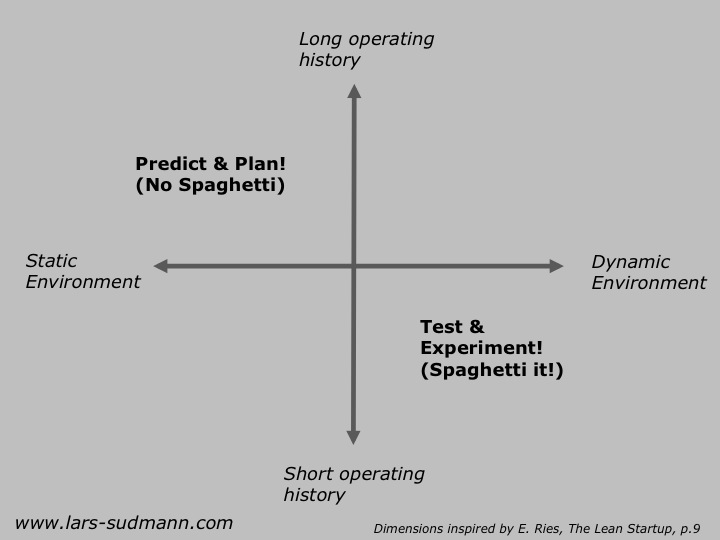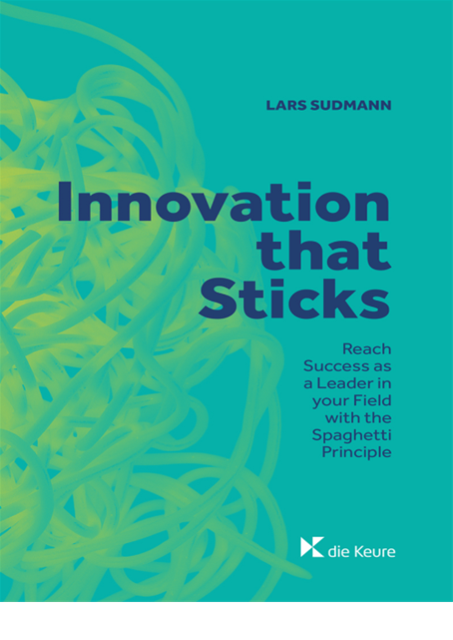In a meeting somebody said, in a somewhat condescending tone:
“They are using the spaghetti technique…”
This was the first time I came across the term. We had been discussing a competitor’s strategy.
“Huh?”, I thought.
“Well, how do you know if a spaghetti is ready after cooking? You throw them at the wall, and see if they stick. That’s exactly what they’re doing with their products. Unprofessional.”
I could see where this principle’s bad reputation came from: It has an unplanned, they-don’t-know-what-they-are-doing ring.
Sure, in a world where you have a long operating history and that is stable and predictable that is not the right approach. That’s where you can create the perfect plan.
But where does this world still exist? Virtually every individual and every industry is affected by complexity and massive change. For instance, Quartz’s David Yanowksiy recently stated that “there is no such thing as a tech company anymore” – as virtually EVERY company has to deal with massive technological change and innovation today.
In a world that is getting more and more complex, throwing spaghetti up the wall and see if they stick might actually be the only way forward.
I advice individuals and organisations to apply this spaghetti principle in daily life: We need to experiment and test much more frequently on all levels of organisations.
There are two important ingredients of the principle: 1) Try out new things regularly; 2) Measure the difference and success and see what “sticks”. If the new approach/strategy/idea works: Great. Let’s keep it – if not. Stop and replace it, no harm done.
This second part is actually very important as we acknowledge that we don’t have all the answers beforehand. We actually don’t know if we will like it, if it will work, if it will be good. But if we don’t try we will never know. It is impossible to forecast. So we need to test, evaluate and repeat.
The spaghetti principle can be applied on all levels:
- On a personal level, you can try out new things frequently for instance via 30 day challenges. Just see what resonates, try it out and see what sticks. Watch the great 4 minute TED talk by Google’s Matt Cutts on areas from taking pictures to stopping TV and starting to write.
- On a team level, you can change the way you approach a meeting, or the way how you conduct strategy updates. Why not try out to have ant-like 1-1 meetings communications instead of the big get-together. Sounds weird? Maybe. But maybe you will cut your meeting time in half. Who knows?
- On an organisational level, this also means trying out new ideas/strategies via a portfolio approach. Let a sub team test new ideas. Do test installations on one manufacturing line. Encourage a subgroup to employ a different idea creation procedure. Revise, discuss, grow!
Especially on the organisational level requires a new mindset. It requires your organisation to start embracing effort / throughput, and not only output. With the spaghetti principle, and in a new unpredictable world, individual output is not guaranteed. This is difficult for many HR policies that praise output and results.
But what is guaranteed is that when you try new things, you will taste and see true innovation. The leader in this scenario is the person who sets the scene to make things happen.
So try out new things. And see what sticks.
Subscribe here to get new posts from Lars directly into your inbox.
Lars Sudmann is an expert on high-performance leadership in global corporations. You can contact Lars to work with you as change consultant, keynote speaker & workshop facilitator for your next event, or executive coach. This article originally appeared on his blog: www.lars-sudmann.com, where you can also watch his TEDx talks.
Images credit: shutterstock.com




